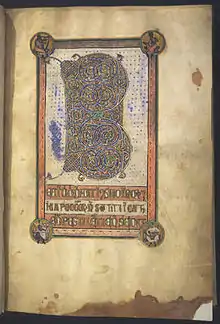
Bethóc ingen Somairle[note 1] was a 13th-century Scottish prioress, considered to have been the first of Iona Nunnery. She was a daughter of Somairle mac Gilla Brigte.
In about 1203, Bethóc's brother, Ragnall mac Somairle, founded the Benedictine Iona Abbey. Sometime afterwards, he founded the Augustinian nunnery on Iona. The precise foundation date of the Benedictine and Augustinian houses are unknown.[2] According to the Book of Clanranald, Bethóc was a "black nun", while the History of the MacDonalds states that she was prioress of Iona.[2] That Bethóc was associated with Iona, as claimed by these clan-traditions, is corroborated by an inscribed stone on Iona. In about 1695, Martin Martin described the Gaelic inscription to have read "Behag nijn Sorle vic Ilvrid priorissa" (which translates as "Prioress Bethóc, daughter of Somairle, son of Gilla Brigte").[4] The transcription was still legible in the 19th century.[2][note 2]
According to Bill Lawson, an entry in the Red Book of Clanranald reads, Beathog inghen Shomhuirle do bhi na mnaoi riagalta & na cailligh duibh. Also do thoguibh Teampall Chairinis anuibhist.[6]
"Beathag, daughter of Somerled, was a religious woman and a Black Nun. It is she that erected Teampall Chairinis in Uist."[7]
Bill Lawson writes, "It is known that Beathag was prioress of Iona in about 1203, the only problem in the ascription to her being that the Islands were still under Norse rule, though of course many of the Norse families would have become Christianized by then."[8]
It has been suggested that Bethóc was the original owner of the Iona Psalter, now preserved in the National Library of Scotland.[2] The psalter appears to have been illuminated in Oxford, in the 13th century.[1] If it was indeed intended for an Ionan prioress, it is uncertain if the psalter ever made it to Iona.[9]
Notes
References
Footnotes
- 1 2 3 Perkins 2006: p. 34.
- 1 2 3 4 5 6 McDonald 1995: pp. 208–209.
- ↑ Sellar 2004.
- ↑ Sellar 1966: p. 129.
- ↑ Sellar 1966: p. 129 fn 7.
- ↑ Bill Lawson (2004), North Uist in History and Legend, Birlinn. Page 79.
- ↑ Bill Lawson (2004), North Uist in History and Legend, Birlinn. Page 79.
- ↑ Bill Lawson (2004), North Uist in History and Legend, Birlinn. Page 79.
- ↑ Higgitt 2000: p. 278.
Bibliography
- Higgitt, John (2000), The murthly hours: devotion, literacy and luxury in Paris, England and the Gaelic west, University of Toronto Press, ISBN 978-0-8020-4759-5.
- McDonald, Russell Andrew (1995), "Scoto-Norse kings and the reformed religious orders: patterns of monastic patronage in twelfth-century Galloway and Argyll", Albion: A Quarterly Journal Concerned with British Studies, The North American Conference on British Studies, 27 (2): 187–219, doi:10.2307/4051525, JSTOR 4051525.
- Curran, Kimm (2006). "Bethoc (Beatrice), daughter of Somerled". In Ewan, Elizabeth; Innes, Sue; Reynolds, Siân (eds.). The biographical dictionary of Scottish women: from the earliest times to 2004. Edinburgh University Press. ISBN 0-7486-1713-2..
- Sellar, William David Hamilton (1966), "The origins and ancestry of Somerled", The Scottish Historical Review, Edinburgh University Press, 44 (140): 123–142, JSTOR 25528658.
- Sellar, William David Hamilton (2004). "Somerled (d. 1164), king of the Hebrides and regulus of Argyll and Kintyre". Oxford Dictionary of National Biography. Oxford Dictionary of National Biography (online ed.). Oxford University Press. doi:10.1093/ref:odnb/26782. (Subscription or UK public library membership required.). (subscription or UK public library membership required)
Further reading
- McDonald, Russell Andrew (1999), "The foundation and patronage of nunneries by native elites in twelfth- and early thirteenth-century Scotland", in Ewan, Elizabeth; Meikle, Maureen M. (eds.), Women in Scotland, c.1100–c.1750, Tuckwell Press, pp. 3–15, ISBN 1-86232-046-2.